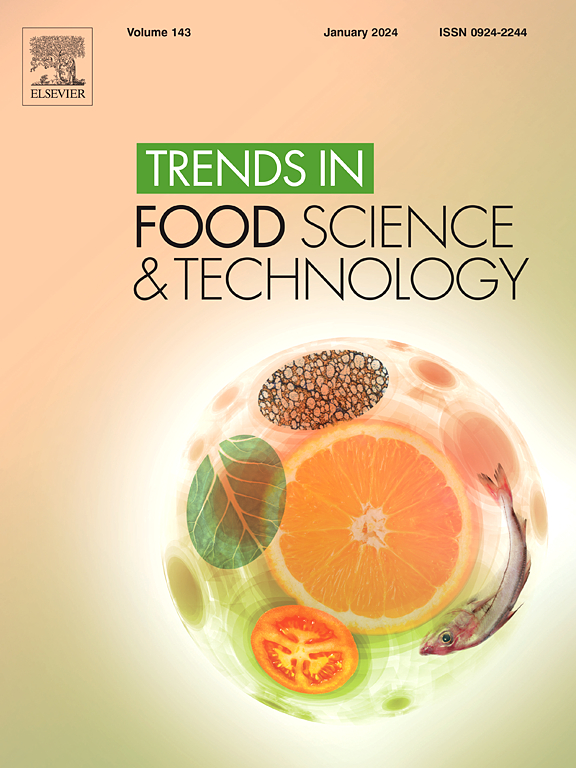以碳水化合物为基础的脂肪模拟物:关注脂肪模拟机制和摩擦学观点
IF 15.1
1区 农林科学
Q1 FOOD SCIENCE & TECHNOLOGY
引用次数: 0
摘要
像菊粉这样的脂肪模拟物可以有效地减少食物中的脂肪,同时模拟脂肪的味道和质地。然而,脂肪模拟物在风味和质地上与真实脂肪仍有较大差距,对脂肪模拟机制的研究也不足。因此,揭示脂肪模拟物在模拟脂肪结构中的作用机制尤为重要。这是改进其设计,增强模拟效果,推进低脂健康食品开发,促进公众健康的关键。本文综述了碳水化合物类脂肪模拟物的研究进展及其机制。它们被概括为三维网络结构和微粒假说。此外,基于摩擦学,我们提出了结构应变、口腔加工和感觉知觉的新机制。基于碳水化合物的脂肪模拟物形成三维凝胶网络,稳定水并提供脂肪般的润滑。同时,天然或加工过的碳水化合物可以形成微小的颗粒,模仿脂肪球,复制脂肪的光滑纹理。值得注意的是,它们独特的结构使触变流体行为,在咀嚼力下表现出“弹性-滑动-粘附”应变。这有利于边界润滑、混合润滑和流体动力润滑状态之间的转换,如口腔摩擦系数曲线所示。将口腔润滑模型与感官评价相结合,揭示了平滑度和厚度感知的机制。总之,本文强调了脂肪模拟物的动态口腔加工特性,并将对脂肪模拟机制的理解从静态流变模型扩展到动态摩擦学框架。本文章由计算机程序翻译,如有差异,请以英文原文为准。
Carbohydrate-based fat mimetics: A focus on fat-mimicking mechanisms and a tribology perspective
Background
Fat mimetics such as inulin can effectively reduce fat in foods while simulating the fat-like taste and texture. However, there are still significant gaps between fat mimetics and real fat in terms of flavor and texture, and the research of fat-mimicking mechanisms is also insufficient. Therefore, uncovering the mechanism of action of fat mimetics in simulating fat structures is particularly important. This is key to improving their design, enhancing simulation effects, and advancing low-fat, healthy food development to promote public health.
Scope and approach
This review aims to provide an overview of research on carbohydrate-based fat mimetics and the related mechanism. They were summarized as the three-dimensional network structure and microparticulate hypothesis. Furthermore, based on tribology, we proposed a new mechanism in terms of structural strain, oral processing, and sensory perception.
Key findings and conclusions
Carbohydrate-based fat mimetics form a three-dimensional gel network that stabilizes water and provides fat-like lubricity. Meanwhile, natural or processed carbohydrates can form tiny particles that mimic fat globules and replicate fat's smooth texture. Notably, their unique structure enables thixotropic fluid behavior, exhibiting "elastic-sliding-adhesion" strain under chewing forces. This facilitates transitions between boundary, mixed, and hydrodynamic lubrication states, as shown by oral friction coefficient curves. Integrating oral lubrication models with sensory evaluations reveals the mechanisms of smoothness and thickness perception. In a word, this review highlights the dynamic oral processing characteristics of fat mimetics and expands the understanding of fat simulation mechanisms from static rheological models to dynamic tribological frameworks.
求助全文
通过发布文献求助,成功后即可免费获取论文全文。
去求助
来源期刊

Trends in Food Science & Technology
工程技术-食品科技
CiteScore
32.50
自引率
2.60%
发文量
322
审稿时长
37 days
期刊介绍:
Trends in Food Science & Technology is a prestigious international journal that specializes in peer-reviewed articles covering the latest advancements in technology, food science, and human nutrition. It serves as a bridge between specialized primary journals and general trade magazines, providing readable and scientifically rigorous reviews and commentaries on current research developments and their potential applications in the food industry.
Unlike traditional journals, Trends in Food Science & Technology does not publish original research papers. Instead, it focuses on critical and comprehensive reviews to offer valuable insights for professionals in the field. By bringing together cutting-edge research and industry applications, this journal plays a vital role in disseminating knowledge and facilitating advancements in the food science and technology sector.
 求助内容:
求助内容: 应助结果提醒方式:
应助结果提醒方式:


